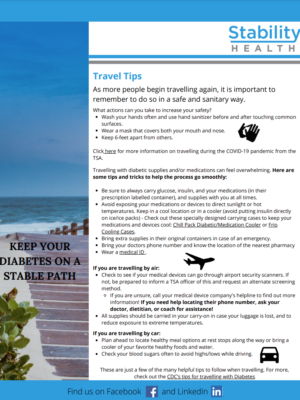
As more people begin traveling again, it is important to remember to do so in a safe and sanitary way.
What actions can you take to increase your safety?
- Wash your hands often and use hand sanitizer before and after touching common surfaces.
- Wear a mask that covers both your mouth and nose.
- Keep 6-feet apart from others.
Click here for more information on traveling during the COVID-19 pandemic from the TSA.
Traveling with diabetic supplies and/or medications can feel overwhelming.
Here are some tips and tricks to help the process go smoothly:
- Be sure to always carry glucose, insulin, and your medications (in their prescription labelled container), and supplies with you at all times.
- Avoid exposing your medications or devices to direct sunlight or hot temperatures. Keep in a cool location or in a cooler (avoid putting insulin directly on ice/ice packs) – Check out these specially designed carrying cases to keep your medications and devices cool: Chill Pack Diabetic/Medication Cooler or Frio Cooling Cases.
- Bring extra supplies in their original containers in case of an emergency.
- Bring your doctors phone number and know the location of the nearest pharmacy.
- Wear a medical ID.
If you are traveling by air:
- Check to see if your medical devices can go through airport security scanners. If not, be prepared to inform a TSA officer of this and request an alternate screening method.
- If you are unsure, call your medical device company’s helpline to find out more information! If you need help locating their phone number, ask your doctor, dietitian, or coach for assistance!
- All supplies should be carried in your carry-on in case your luggage is lost, and to reduce exposure to extreme temperatures.
If you are traveling by car:
- Plan ahead to locate healthy meal options at rest stops along the way or bring a cooler of your favorite healthy foods and water.
- Check your blood sugars often to avoid highs/lows while driving.
These are just a few of the many helpful tips to follow when traveling. For more, check out the CDC’s tips for traveling with Diabetes
Meal Preparation
Do you ever finish a long day and the last thing you want to do is prepare dinner? If so, then this may be for you!
Meal Planning is a great tool to stay fueled throughout the week with nutritious meals and snacks.
- Plan all of your meals and snacks for the week so you know exactly what to buy.
- Prepare meals in advance for easy week night leftovers.
- Stay on track with your nutrition goals.
Plan ahead. This allows you to:
- Buy only what you need, not excess items. The average family of four throws out nearly $1,600 worth of produce every year.
- Choose nutritious, well-rounded meals that are easy to make.
- Have a home-cooked meal ready within minutes of getting home.
Prepare
- Pick one or two (or more) days that work best for you. Prepare the meals/snacks you planned.
- Portion them out into individual servings and store in food storage containers.
- Store meals in the refrigerator for three to four days to prevent spoilage. For more information on how long different foods keep for, check out the USDA Food Keeper App!
Stay on track. Having meals ready can:
- Decrease weeknight stress of cooking a nutritious meal.
- Reduce the times per week you eat out, saving you on average $3,526 per year according to the Bureau of Labor and Statistics.
- Research shows that home cooked meals are associated with a healthier diet.
Getting Started.
Do you want to try meal planning but do not know where to start? Check out this video from the Academy of Nutrition and Dietetics: Basics of Meal Prepping (eatright.org). Looking for recipes? Check out some easy meal prep recipes from the Food Network.
Coach’s Corner
Have you heard the phrase “Sitting is the new smoking”…
Everyone knows that being healthy means that you need to eat right and exercise at least 150 minutes at moderate intensity every week plus get at least 7-9 hours of sleep each day. Raise your hand if you get your 30 minutes in on the treadmill, bike or elliptical and then get on with your day.
Breaking News
New research shows that just getting in that 30 minutes of cardio exercise daily is not enough if you have a sedentary lifestyle. It is important to keep your body moving in light activity through the day.
It is recommended that all adults, particularly those with type 2 diabetes, should avoid sitting for long periods of time. Sitting needs to be interrupted every 30 minutes for better blood glucose benefits.
How can I do this when I work in an office?
- Every 30 minutes you need to move your body
- Set a timer or use your clock
- Stand up and stretch for a couple of minutes
- Use an under desk “bicycle”
- Take a walk to the bathroom, water fountain or hallway
How can I do this if I drive for work?
- Stretch and move your shoulders/arms at every stop light/sign
- At the rest area, take a walk for 5 minutes
- Between picking up/dropping off passengers, take a short walk
Talk to your coach for more information – start reducing your risks. Small steps can lead to big changes.
